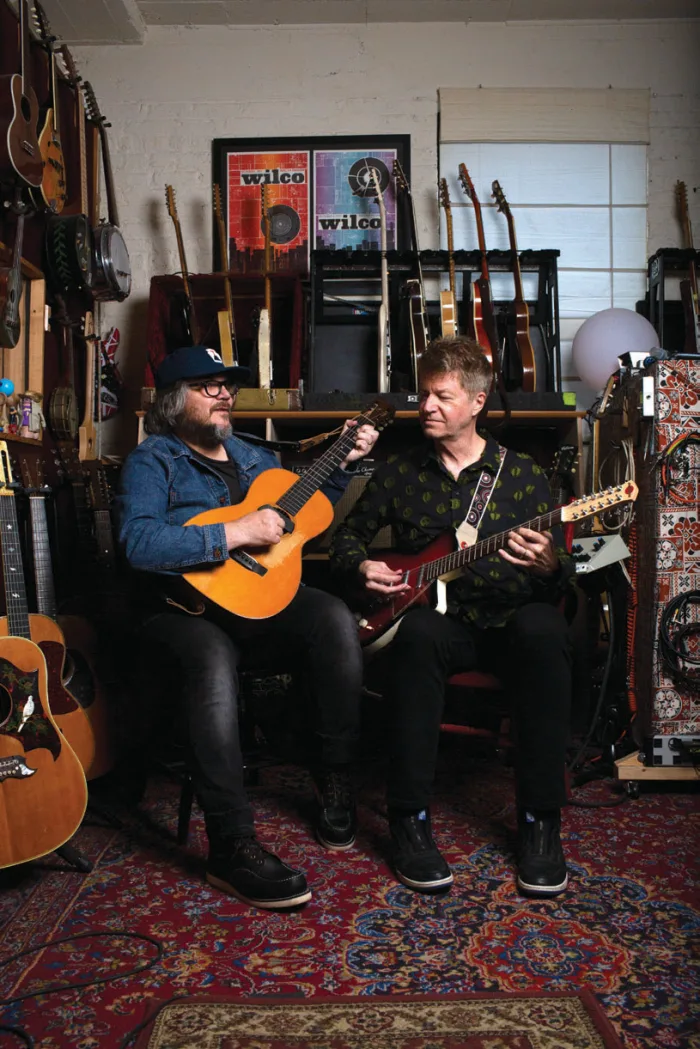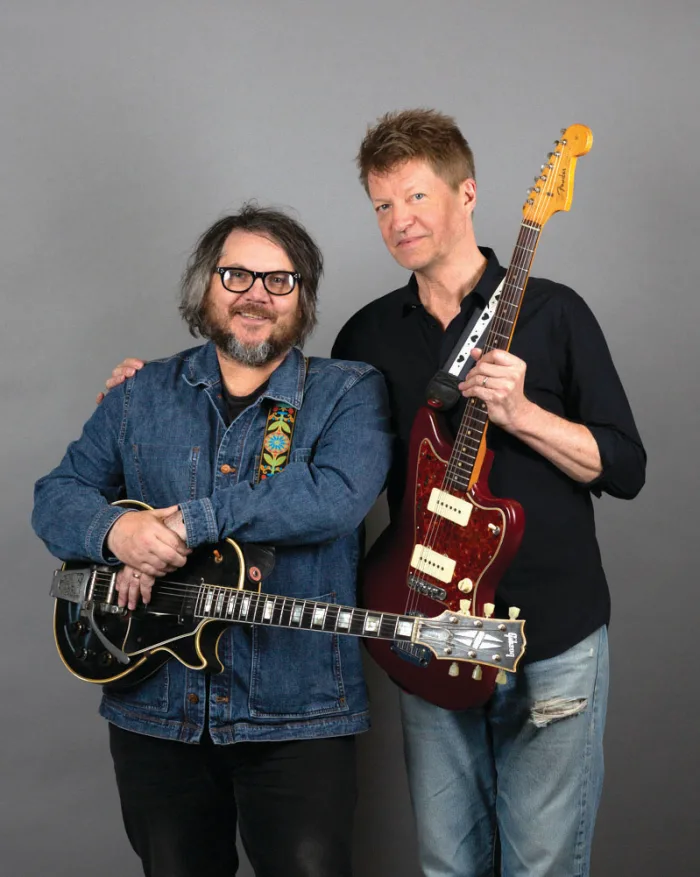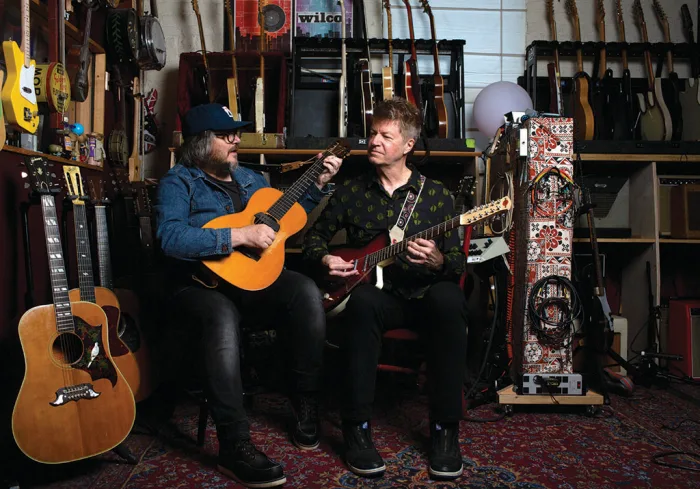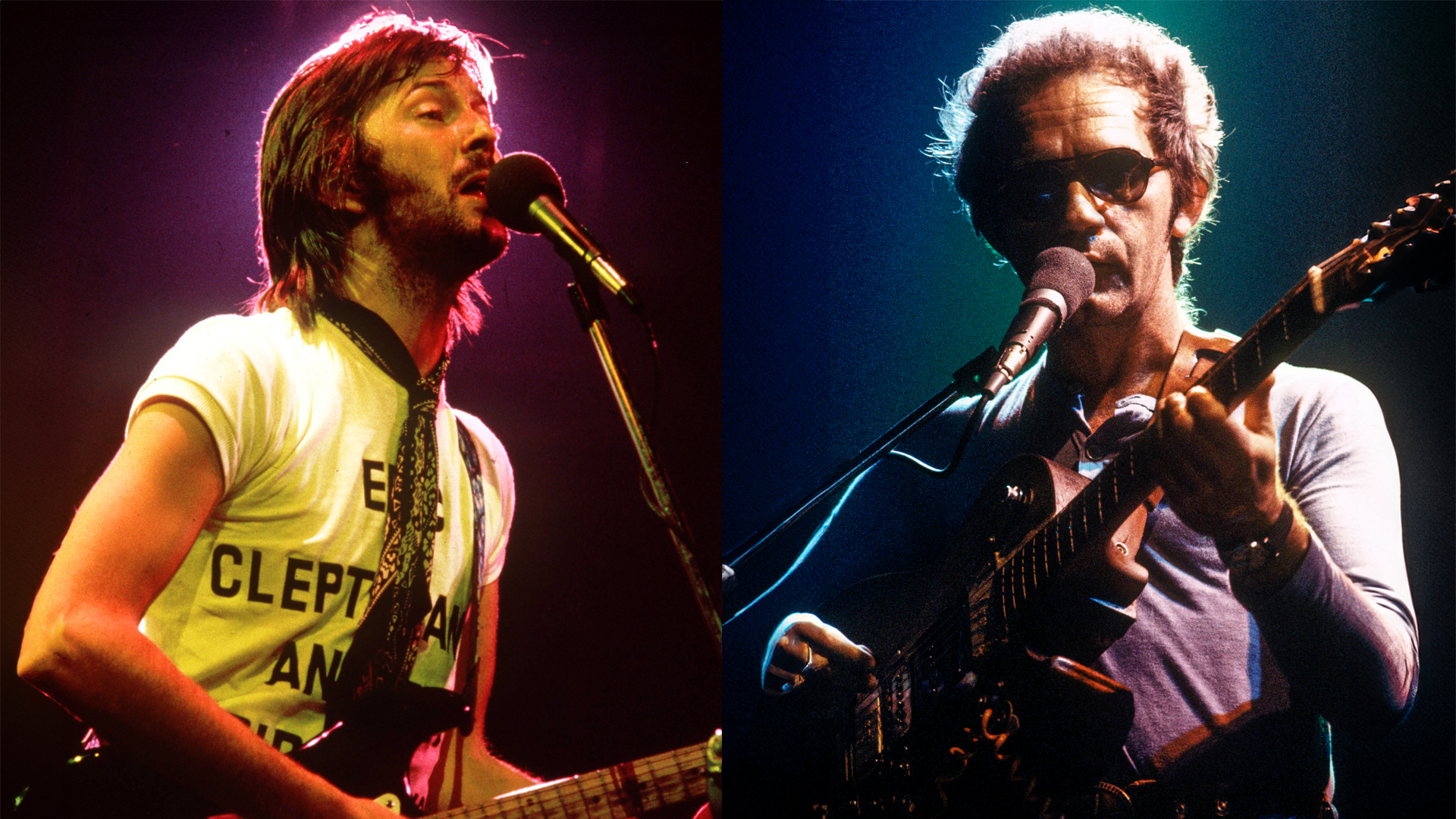Jeff Tweedy and Nels Cline on How Cheapo Guitars and Rubber Bridges Helped Them Find Happiness on 'Ode To Joy'
Though its background was anything but orthodox, 'Ode to Joy' finds Wilco as adventurous and cohesive as ever.

To say that Wilco have their own thing going is a big understatement for a band that has been a defining force on the alternative-rock scene for the past quarter century.
The brain trust of the lineup - drummer Glenn Kotche, bassist John Stirratt, keyboardist Mikael Jorgensen, multi-instrumentalist Pat Sansone and guitarist/sonic sculptor Nels Cline - has remained unchanged for 15 years. That durability is a testament to the creative bond they have with vocalist/guitarist/songwriter Jeff Tweedy, who has been the mastermind behind Wilco’s sound since its inception in 1994.
Typically working alone at his Loft studio in Chicago, Tweedy has unfettered freedom to steer the band wherever his muse leads, and thusly it’s completely in character that laying the groundwork for the new album, Ode to Joy (Wilco’s 11th studio release), would be anything but orthodox. Tweedy and Kotche paired up to strategize on constructing what the guitarist calls “really big folk songs… Monolithic, brutal structures that delicate feelings are hung on,” while simultaneously deconstructing what most would consider the unassailable foundation of any rock project: the beat.
“One of the things that Glenn and I talked about was what would it sound like if somebody was trying to make a rock record from memory, but they had no access to the actual source material,” Tweedy says. “Like, if 300 years from now you’d only heard about rock music from people talking about it. So we made a concerted effort to avoid talking about sound and things in reference to anyone else’s music or records. In other words, instead of saying, ‘What if the drums sounded like T. Rex?’ you might say, ‘What if the drums sounded so depressed they could hardly walk?’ And then you have to use your imagination and try and figure out what those sounds are and express yourself within those parameters.
“So before everybody got together in December of last year, we kind of demoed the songs and built this atmosphere that started the ball rolling in terms of how much deconstruction we were going to try and employ. I would lay down a foundation of a song with a drum machine so that it would be fairly simple, and then we would take the drum machine and completely obliterate it and distort it to where it became a different rhythm.
"If you distort something enough, it stops being rhythmically correct. It compresses and becomes a little bit behind the beat. Glenn would write those rhythms down and then go play them. And sometimes he would do it one drum at a time, because he’s good enough to do that. Another reason why the drums sound the way they do is that each drum was recorded very deliberately as its own instrument, as opposed to as a kit. A good place where you can hear that is the drum pattern at the end of ‘Before Us,’ which is basically a notated version of a distorted drum machine.”
That approach makes recreating the songs onstage an unusual proposition, as Nels Cline explained prior to Wilco’s European tour this past September, when this interview took place. “I think this record is maybe the quirkiest as far as reproducing the recorded sound,” Cline says. “Glenn came up with a completely unusual and innovative drum set to play some of these parts because, other than the songwriting and Jeff ’s voice, the percussion and drums are really the central sound of the record. A lot of the drum beats are based on one and three instead of two and four, so they’re not typical rock beats. It’s like marching or being flogged or something, and there’s barely a cymbal on the entire record.”
All the latest guitar news, interviews, lessons, reviews, deals and more, direct to your inbox!

Cline could be describing the opening cut, “Bright Leaves,” with its sedated vocal delivery over a plodding groove, or “One and a Half Stars,” where Tweedy’s deadpan refrain of “If I stay in bed all day I won’t escape my domain” is carried pallbearer-style by a pulsing beat with mere breaths of instrumentation. But there’s method to the madness here, and Tweedy seems to be purposely setting up the fourth song, “Quiet Amplifier,” to pull open the drapes with layers of blossoming orchestration that culminate in a striking guitar solo that he plays over a cacophony of noise before it all suddenly melts away in a two-chord acoustic vamp.
“I worked on that one in a lot of different incarnations of that same basic track before we got to how it sounds with Wilco,” Tweedy explains. “It all came originally from this C# tuning, which is C# G# C# G# G# C#. The B string ends up being super slack, and those unison strings next to each other kind of create some almost slide-sounding stuff. And the acoustic guitar bed is generally fingerpicking that tuning with a melody that goes through the whole song, which is that ethereal, high Theremin-sounding melody. Then I just got kind of bored and started layering different things.
"A lot of times I think of guitars as guys. I don’t think of them as me. I still like listening to records and picturing a group of musicians, so when layering guitars, I just want each guy to have a purpose, you know? There’s some guys that don’t really know what to do with that tuning, and there’s one guy that can’t shake the idea that it’s a Rolling Stones song. It all manages to work somehow, but to me there are a bunch of things that don’t belong together on that track, which I found exciting.”
Cline adds, “All I do on that song is some droning feedback, but I wanted it to be my Jerry Jones 12-string, the same one I’ve been playing live with Wilco since the beginning. It’s hollow inside, so it feeds back beautifully. The layering and orchestration and the dynamic power of ‘Quiet Amplifier’ was kind of implicit before we even overdubbed on it, but it just became even more dynamic after we added our bits. Jeff has a lot going on, and when the guitar comes in and he’s doing those stabbing, ripping leads, there’s something very Velvet Underground about it. Very Lou Reed. I could never get as free and raw on a track as he can. I think he’s a very underrated guitar player.”
Jeff, what can you tell us about the gear you used?
Jeff Tweedy I tend to use a really small set of gear. When it comes to actually putting something on tape, it’s a really beat-up ’50s Les Paul with Alnico P-90s through a Fender Champ. If I want a thick distorted sound, that’s it. Then I have a top-loader Esquire that I use for anything that’s bright, and that’s usually through a Princeton. I can get a lot of stuff done with just that little arsenal. Occasionally, I will put something in the chain, but only one pedal at a time, like a Fairfield Shallow Water if I want some kind of crazy warble, or a [Dallas] Rangemaster as a treble booster. I have a pretty good grasp of what all of the pedals do, and I have a vast collection that I can go to for the things I want to hear.

Do you still source new pedals?
Tweedy The guys at Chicago Music Exchange are pretty in tune with things that I might find interesting, whether it’s old guitars, amps or other gear. A lot of pedals are just a rehash of things that already exist, and I tend to not be that interested in those. For a while, every pedal that claimed to be doing something different was kind of a variation on a [Mid-FI Electronics] Pitch Pirate or some other glitchy-sounding thing. But I read about pedals a lot, and I’m online all the time looking at demos because I’m a nerd.
Once a month or so I’ll find something that I haven’t heard and would love to have at my disposal to mess around with, like the Plasma pedal by Gamechanger Audio, where you can control the voltage and get some craziness happening. But I tend to shy away from things that have deep controls, like a lot of knobs, and also programmable pedals. I don’t have time for that. In theory, it looks like it would be really fun to be able to sculpt something, but to me it never seems to end up having as much tone as something simpler.
I also tend to be suspicious of things that aren’t moving any air. I like things that f*ck up the signal, and then that signal gets reproduced in an amp, but a lot of the new reverbs and delays don’t sound to me like they belong on a track. Maybe I’m just spoiled by having a nice plate reverb and a nasty-sounding stairwell!
Nels, how did you approach the challenge of crafting tones that would enhance Jeff’s aspirations for this album?
Nels Cline: It’s kind of an intuitive process, and there’s not any assurance that when I do decide on something it’s going to fly. Basically, I just try things until Jeff is happy and gives it the thumbs up. He’ll let me do whatever I want, but he may completely put me on another track at some point. I think sometimes my first impulse is to just assess the harmonic aspects and the mood of the song and go from there. But sometimes that’s a little safer than what Jeff is looking for, and he has to nudge me into slightly less reverent musical territory. And maybe slightly less generic too.
I’m not saying I’m striving for generic, because certainly I’m not, but I’m trying to be respectful to the song and not rip it apart in the very beginning. But sometimes Jeff wants it ripped apart, and I let him direct me into that zone. Sometimes I’m surprised that, even though I’ve just barely formed an idea for a sound, he’ll say he likes it and it’s a cool direction. That’s always helpful, because then I can move forward with some degree of confidence.
Do you find that the instrument itself also influences what you play?
Cline Sometimes, yes. In my case, it’s less about the feel of the instrument than the sound, so I’ll generally choose something based on its tonal qualities. For example, if I’m hearing something super thin and needle-y in my head, I’ll use my old green Hofner 12-string or an EKO, or pull out my Silvertone or Jerry Jones Danelectro-type guitars. On this record, Jeff was wanting me to mostly play my Jazzmaster that I’ve been playing since ’95 - the one I bought from [ex-Minuteman bassist] Mike Watt - but that didn’t necessarily fly with me on every track.
There’s really no limit to how many ideas I’m allowed to try. But I prefer to work very quickly, so I’m not going to sit there and pull out a million different amplifiers and weird guitars thinking I’ll come up with something. There was a time when I was first in Wilco where I thought this was a possibility and an exciting idea, but it’s just too laborious and indulgent, so I don’t do that. I just use a couple of amplifiers and don’t even set up my whole pedalboard that I use live.
I just find some things that I have or Jeff has - and there are tons of pedals and amps at the Loft to choose from - and I kind of take it from there. And if I hear something I don’t have, I go find it and add it to my setup and work from there.

Your solo really jumps out on “Everyone Hides.” What did you use for that one?
Cline I used my Watt Jazzmaster and a Klon Centaur through a Milkman one-twelve combo, which is modeled after a Princeton Reverb, but with a little extra oomph. I was basically playing something that Jeff had played on the demo, which was like two or three solos all at the same time. I don’t think I would ever play that kind of blathery, overlayered two or three solos all playing at the same time for 10 seconds, but Jeff ’s a creative guy, and what can I say?
At the end of the song there’s this howling slide stuff going on in the background, and I came up with that. I used the Goo overdrive [Cline’s signature ToneConcepts pedal] with a ton of long delay, and I was doing controlled feedback with the bottleneck. It was inspired completely by a guitar sound on the album Meat Puppets II.
Do you intentionally use tones that suit that song but aren’t necessarily what you might think of as ideal lead guitar tones?
Cline Yes, and a good example of that is the song “Impossible Germany” [from Wilco’s Sky Blue Sky album], which has become this weirdly iconic guitar-solo song at a time when such things really don’t exist in the lexicon. It’s very much of my era, meaning the ’60s and ’70s, and the tone on that solo I chose for the song, not because I thought it was an attractive tone. It’s my Jazzmaster with the bridge pickup and my Klon Centaur overdrive, and I wouldn’t normally choose the bridge pickup because I’m a total neck-pickup kind of guy. I feel the most relaxed when I get a tone that I like, and it’s almost always going to be dark. But I chose that tone because I thought the song benefitted from it, and it just spoke in a way that seemed commensurate with the mood or something.
I’ve played that song virtually every night for almost 15 years now, and it’s still hard for me to relax with that tone and play a decent solo, because I’m wanting to switch to the neck pickup. So I don’t always select things based on my comfort zone. I’d rather do what the song wants. It’s one of the joys and challenges of playing with Wilco or collaborating with anybody that has different tastes or a different vibration level than me. It’s something I like doing, though, because I like flexing.
Jeff, how do instruments inspire your songwriting?
Tweedy I write almost all my songs on acoustic guitar. I have a lot of different instruments and a lot of acoustic guitars, and the ones I end up writing on are generally the ones that have almost no sustain and have really dead strings. There are some old beater guitars that I leave laying around the house that I always end up writing on, and recently I’ve been getting these guitars built that have a rubber bridge.
I used them on the record, and they sound sort of like a ukulele and classical guitar. They’re terrible old ’40s stencil cowboy guitars or cheapo beginner guitars, but you put a rubberized bridge on them and they have this crazy quality that just leaves so much more room for my voice. I don’t have a real sustaining voice so I tend to like guitars that aren’t showing me up.
How did you find out about rubber bridges?
Tweedy I think I first heard the sound of this particular type of instrument from an artist by the name of Perfume Genius [a.k.a Mike Hadreas]. He has a song on the most recent record he did [2017’s No Shape] that has this really lovely plucked quality to it. I saw him perform on a Tiny Desk concert on NPR, and the guitar he was playing looked like a Telecaster but sounded like the instrument on the record. Then we did a festival with Perfume Genius and I got to see the instrument in person. I asked him where he got it, and he told me about this guy in California named Rubin Cox [who works out of the Old Style Guitar Shop in Los Angeles]. So I contacted the guy and asked if he had any available, and he sent some pictures, and I bought one and fell in love with it.
Then I bought some other guitars that are conducive to this kind of transformation. They’re generally crappy old Harmony and Airline guitars from the ’50s, or like a Roy Rogers stenciled-cowboy-scene guitar that somebody would just hang on the wall, but they’re surprisingly well-intonated. I put flat-wound strings on them.
How do alternate tunings impact your songwriting?
Tweedy I use weird tunings as a catalyst for songwriting a lot. A lot of times just disorienting yourself by not being able to grab rote chords, or not knowing what’s going to happen when you move your fingers, can be very inspiring. If I get stuck on a song I’ve written in standard tuning, sometimes I’ll do an overdub in a weird tuning that I’ve put together so that it would be in the same key.
Can you explain how disorienting yourself helps the process?
Tweedy I’ve been writing songs since I was 14 years old, and I really like feeling in control of it. I like feeling that I’ve worked hard at the craft of songwriting and have an understanding of what you’re looking for something and you can get from A to B quickly without too many missteps.
But I also have a lot of mistrust for my ego, and when you disorient yourself, you really have subverted your ego quite a bit, because you’ve let go of all of that expertise or whatever you’ve accumulated as knowledge. You’re reacting the way I think you react when you listen to other peoples’ music and you hear something that grabs your ear and it’s beautiful. It’s just a way to trick yourself. My main job is to trick myself into not having my ego trying to be clever and smart and show off something that doesn’t matter to anybody.
“White Wooden Cross” is an amazing song with some echoes of George Harrison in the solo section. What were you shooting for on that one?
Tweedy We had tried a couple of different approaches to the solo on that song. I think Pat [Sansone] had taken a stab at it with a beautiful direct-into-the-board 12-string solo, and he did a lot of things that sounded great, but they just felt more familiar to me than what we ended up with. I was trying not to be too George Harrison, to be honest, so I guess I didn’t do a very good job. [laughs] Initially, it was a guitar synthesizer that I ended up putting a slide over too.
I don’t know if you can still hear the synth that much, but it’s like an early GS-500 or whatever those first-generation Roland synths were called. It’s a pretty unwieldly instrument, but I was just trying to shake out of things that I’ve heard and trying to disorient myself a little bit. I didn’t really intend to keep the solo for myself; I just wanted to put something down to see if Nels or Pat or somebody wanted to elaborate on it. And I guess we either ran out of time or everybody thought it was something we liked enough to not want to mess with it. I don’t remember which, but I like it. I’m sure it’s my ’59 Esquire you’re hearing there.
Did you also use the Esquire for the chiming fingerpicked parts on “Love is Everywhere”?
Tweedy No, that was my Gretsch Duo Jet through a Princeton Reverb. I think I ended up grabbing that because there was something weird with the intonation on the Esquire, or it didn’t like the capo on the third fret. I did a demo of that song a long time ago, so I knew the fingerpicking part a little better than Nels had time to get comfortable with when we were tracking. I just laid it down because it was already in my head. A common trait in the Wilco camp is that everybody is geared toward the record and the song, and there’s not a lot of fighting over territory. I think that’s a really healthy place for a band to be.
On “Hold Me Anyway,” how did you come up with those harmonized parts?
Tweedy Originally, I wanted all of that to be a horn section. I really wanted there to be this big outburst of joy and celebration. I think I had that guitar tone dialed up for something else, but when you put a part like that down, it’s almost impossible not to try a harmony, because that’s where your mind goes. It’s another one like the “Love Is Everywhere” part, where there’s a lot of pull-offs and things that feel pretty natural to me.
I thought my kid-in–Guitar Center playing was over the top and hilarious sounding in the context of the lyrics, but it just kind of stuck. We did try replacing the guitars with a horn section, and I also tried just one guitar with a different tone, but everything felt just a little bit less special and didn’t communicate that same sense of surprise and joy.
You managed to make those harmonized parts sound quirkier and more intriguing than the usual twin-guitar fare.
Tweedy Well, it’s a combination of sort of knowing what I’m doing and using some pretty f*cked-up tones on the harmonies. Usually the doubles are a cocked-wah-pedal sound, like what you hear on a lot of older records, but it’s not quite as nasty sounding as the stuff that makes me smile.
Nels, how do you go about reproducing those harmonies live?
Cline Well, there’s a saxophone in there that Paul Von Mertens is playing, and once again that’s Jeff and his intuitive army of guitar stuff. He didn’t seem to remember how he got that sound when I asked him, and he didn’t tell me he was doing that sort of roll-the-tone-knob-off with tons of distortion. We’re trying to do it live now with Pat playing horn parts on a Mellotron and me playing my Cloud 9 Les Paul with the tone knob rolled all the way down. I’m also using a JHS Muffuletta, which is like six or seven Big Muffs in one.
When I do it live, the first thing that pops into my head is Robert Fripp. Because with the Muffuletta and a Les Paul with the tone knob rolled down - and the fact that Jeff has a pretty fast finger vibrato, and so does Fripp - as soon as I hear that sound I want to play like “Starless” or something. It’s really uncanny.
- Save cash on the best electric guitars under $500

Art Thompson is Senior Editor of Guitar Player magazine. He has authored stories with numerous guitar greats including B.B. King, Prince and Scotty Moore and interviewed gear innovators such as Paul Reed Smith, Randall Smith and Gary Kramer. He also wrote the first book on vintage effects pedals, Stompbox. Art's busy performance schedule with three stylistically diverse groups provides ample opportunity to test-drive new guitars, amps and effects, many of which are featured in the pages of GP.
